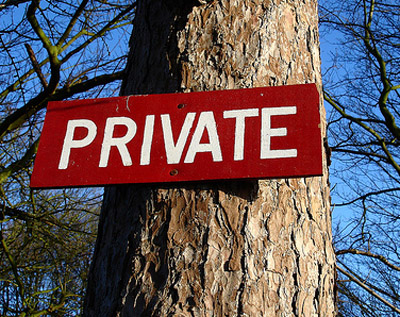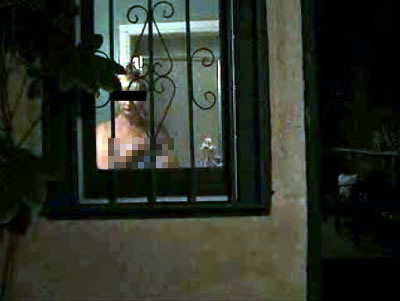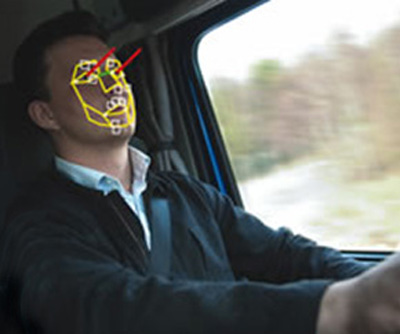Jun 23, 2008
Inside / Outside Part I: A New Paradigm of Privacy
The right to personal privacy: this might be the only right we have which hinges entirely on our expectations of it. That is, our right to privacy is dependent on our expectation of privacy — and when we have no expectation of privacy, generally speaking we have no right to privacy either.
 Our sense of personal privacy is linked to our ideas of public versus private: public space, which is physical space theoretically accessible to everyone (like public parks, sidewalks, and roads, but also including privately owned space which is open to the general public, such as retail space, restaurants, theatres, etc.), and the public sphere, a conceptual forum in which discourse of issues related to public life can take place (including town hall meetings, the PTA meetings, the senate floor, and the pages of privately owned publications like newspapers). The former is generally conceived terms the ownership of and access to property, while the latter is typically considered a discursive arena which liaises the functions of politics and private commerce.
Our sense of personal privacy is linked to our ideas of public versus private: public space, which is physical space theoretically accessible to everyone (like public parks, sidewalks, and roads, but also including privately owned space which is open to the general public, such as retail space, restaurants, theatres, etc.), and the public sphere, a conceptual forum in which discourse of issues related to public life can take place (including town hall meetings, the PTA meetings, the senate floor, and the pages of privately owned publications like newspapers). The former is generally conceived terms the ownership of and access to property, while the latter is typically considered a discursive arena which liaises the functions of politics and private commerce.
What public space and the public sphere have in common is, obviously, that they’re public. There’s no expectation of privacy (which I will loosely define as the ability to withhold information about one’s actions, opinions, or property) in public. It sounds obvious, but it’s not; taking for granted a relationship between privacy and publicness is the root of many of the contentious issues surrounding personal privacy today. So to be really clear: when in public, if one has not tried to conceal something, then one has no reasonable expectation of privacy, and therefore can make no claim to a right of personal privacy. It couldn’t be simpler. Right?
 But what about public bathrooms and public changerooms? A lockerroom is definitely public space, in that it’s accessible to anyone of a certain gender, but would people behave differently if they knew they were being videotaped? A restaurant is public space, but conversations about sensitive issues are often conducted there; would people still discuss these sensitive issues if they knew the people at the next table were listening? What if they knew they were being recorded? Is it obscene to perform sex acts in one’s own living room — in front of an open window? Does a couple have an expectation of privacy if they argue so loudly their voices carry through walls? What about actions performed in extremely remote areas of national parks, where it’s not unreasonable to expect to go unseen in technically public space? There are degrees of publicness, and it’s never quite black and white — and often (but not always) the grey area is a result of the introduction of some new technology.
But what about public bathrooms and public changerooms? A lockerroom is definitely public space, in that it’s accessible to anyone of a certain gender, but would people behave differently if they knew they were being videotaped? A restaurant is public space, but conversations about sensitive issues are often conducted there; would people still discuss these sensitive issues if they knew the people at the next table were listening? What if they knew they were being recorded? Is it obscene to perform sex acts in one’s own living room — in front of an open window? Does a couple have an expectation of privacy if they argue so loudly their voices carry through walls? What about actions performed in extremely remote areas of national parks, where it’s not unreasonable to expect to go unseen in technically public space? There are degrees of publicness, and it’s never quite black and white — and often (but not always) the grey area is a result of the introduction of some new technology.
In an earlier post, I wrote about the privacy issues surrounding Google’s Street View; if you’re in public space, does that automatically mean you’re in public? Traditional wisdom might say “yes,” but technology can augment publicness when one’s image is captured and distributed via the Internet. Even in plain view in public space, there is some expectation of privacy (in the sense of an ability to conceal one’s actions), hence the protection of people whose images are captured in public — in essance, a public action is made private — and a host of other privacy issues.
Take, for instance, on-the-job drug testing. At work, we generally assume we don’t have the degree of privacy we enjoy at home — but is drug-testing an invasion of privacy on the job? If you’re at work, technically your actions fall into the sphere of your place of employment, but then, is drug testing going to judge the actions you perform in the sphere of your employment, or in your own home, off-the-clock? What used to be as cut-and-dried as how well you performed on the job is complicated by a bit of technology that can blur the line between behaviour in the home and at work.
 Taking it a step further is this piece of technology described by CTV.ca: the Toronto Transit Commission is exploring the possibility of installing facial scanners capable of measuring the signs of drowsiness or impairment in the faces of drivers. The TTC union will contest them: “‘It’s an invasion of our privacy and we don’t believe it’s necessary in any way, shape or form,’ said Bob Kinnear, president of Amalgamated Transit Union local 113.” An “invasion of privacy”? Don’t supervisors already have the ability to judge whether their employees are too doped up or sleepy to be driving? Aren’t they at work in a public space? Isn’t this just a mechanical extension of a supervisor’s senses? It begs the question: just what is the right to privacy for a transit driver operating a bus or subway? Do workers have the right to conceal their impairment from machines, if not from their human supervisors? Ironically, the facial-scanning technology used to prevent fatigue-related accidents is considered an exclusive special feature in luxury automobiles.
Taking it a step further is this piece of technology described by CTV.ca: the Toronto Transit Commission is exploring the possibility of installing facial scanners capable of measuring the signs of drowsiness or impairment in the faces of drivers. The TTC union will contest them: “‘It’s an invasion of our privacy and we don’t believe it’s necessary in any way, shape or form,’ said Bob Kinnear, president of Amalgamated Transit Union local 113.” An “invasion of privacy”? Don’t supervisors already have the ability to judge whether their employees are too doped up or sleepy to be driving? Aren’t they at work in a public space? Isn’t this just a mechanical extension of a supervisor’s senses? It begs the question: just what is the right to privacy for a transit driver operating a bus or subway? Do workers have the right to conceal their impairment from machines, if not from their human supervisors? Ironically, the facial-scanning technology used to prevent fatigue-related accidents is considered an exclusive special feature in luxury automobiles.
Ultimately, these subtle degrees of privacy or publicness exist not in the mind of the individual or even in the mind of the public at large, but in the laws we use to define privacy. Privacy as most people conceive it is binary: either something is public, or it isn’t. But while it might seem obvious to us that jerking off in front of an open window — in plain view of the neighbour’s kids — is kind of an inappropriate thing to do, to the justice system, it’s not. Likewise, you or I might think if you get photographed walking out of a strip club, that’s your own tough luck — but not so. Then again, if it’s illegal to videotape someone without their permission on a public street, surely it’s illegal to videotape someone without their knowledge in a private home, right? Maybe not. And what’s the difference whether you get busted for sleeping on the job by your boss or by a machine? The laws on privacy in Canada and the US are so nuanced they accommodate or prohibit all sorts of activity in defiance of common sense. New technologies lead to situations that the drafters of our laws could not have anticipated, and as a result, the way privacy laws are applied to these situations doesn’t always make sense.
It will be necessary over the next few years to reconsider our conceptions of public versus private; we cannot continue to apply privacy laws drafted before the invention of digital technology to contemporary situations. As I will write in Part II, the Internet — as a virtual space which exists in both the private and public spheres of discourse, and adds the complication of partial anonymity to boot — complicates things even further.
[Jump to Part II.]
